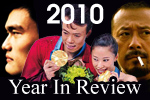Editor's Pick
120 years of winter sports in Spitzingsee
Updated: 2011-01-16 09:02
(China Daily)
|
The Spitzingsee skifields are just a short drive from Munich Airport, but offer grand views and fine sport. Deutsche Presse Agentur |
Schliersee, Germany - The road to Germany's oldest skiing area in the Spitzingsee-Schliersee lakes region is like something from an idyllic postcard.
Traditional Upper Bavarian farmhouses with wooden balconies, roofs covered in deep snow and mountain trails can be seen. The Schliersee Lake at the end of town is frozen in a winter sleep.
If one proceeds through the town, goes past the winter sports museum of Olympic skiing champion Markus Wasmeier and then travels a few kilometres further south one will see a mountain overlooking the scene. Here is a small, but fine, skiing area at Spitzingsee, or as a sign at the entrance says "Wintersportplatz" (winter sports site).
Downhill skiing and snow boarding, cross-country skiing and snow-shoe trekking, sleigh-riding and ice skating - there is nothing that winter sports enthusiasts in the Spitzingsee-Tegernsee ski region can't do. The snow-white peaks of the Rotwand, Miesing, Ruchenkoepfe, Aiplspitz and Jaegerkamp mountains set the framework for the ski runs.
The area is little more than an hour's drive from Munich Airport - virtually at the Bavarian capital's doorstep. The overwhelming number of visitors come only for a few days, notes Stefan Heiss, manager of the mountain lifts at Spitzingsee. "But we also have many vacationers who come here with their children and have purposely chosen a smaller skiing area."
You get on the train at around 1,100 metres elevation and it takes you up to 1,700 metres - making the area Germany's second-highest winter sports setting after the one at the Zugspitze, Germany's tallest mountain.
"With our artificial snow-making machines we can guarantee snow conditions on the slopes from December to April," Heiss says.
In the area around the Stuempfling and Taubenstein mountains is a skiing area that is often referred to as Munich's own mountain. The best view of the surrounding mountain scenery is afforded to skiers taking the black-marked (the most difficult category) ski run on the Rosskopf.
For those who are too challenged by a steep slope, there are many viable alternatives.
"Thirteen red slopes for experienced skiers, five blue slopes for beginners and the small ones rounds out the offering," Heiss says, referring to the intermediate and beginners' categories.
Spitzingsee is considered to be Germany's oldest winter sports venue. Going back more than 120 years, a local book trader imported some wooden skis from Finland and began cutting the first tracks through the snow. Slopes were opened to the new sport and the first skiing races were staged.
The first chairlift was installed in 1949.
But it would take some decades yet before the region would produce a championship-calibre skier: Schliersee's local boy Markus Wasmeier won the 1985 World Championship in the giant slalom and two 1994 Olympic Gold medals in the giant slalom and the super giant-slalom. To this day he is closely attached to his hometown.
But the area is not simply resting on past laurels, but is investing in the future. Snow-making machines, modern lifts, and night-time skiing are being added to the infrastructure. People here know what is possible - and also what is not.
"We have 3,000 parking spaces, which means that at full capacity 5,000 to 6,000 guests come to the ski region," Heiss says. The lifts can handle the ski crowds without waiting times that are too long, and so the slopes are not overcrowded. The ski passes are moderately priced, while one can look in vain for any apres-ski scene at the bottom of the slopes.
Most guests drive back home in the evening anyway - while for the others there are any number of places in the town where they can get warm over a tea with rum.
Specials

Spring Festival
The Spring Festival is the most important traditional festival for family reunions.

Top 10
A summary of the major events both inside and outside China.

A role model
Alimjan Halik had been selected as the "Cyberspace Personality Who Moved the Hearts of the Chinese in 2010".
